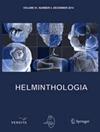鱼类和食物--脂肪食源性线虫 Opisthorchis viverrini 与胆管癌
IF 1.2
4区 生物学
Q4 PARASITOLOGY
引用次数: 0
摘要
摘要 被忽视的热带病(NTDs)是一类与人类有着悠久历史的传染病。NTDs 是贫困的代名词,因为它们影响低收入和极端贫困人口,因为这些人口缺乏适当的医疗保健、清洁水、卫生条件和个人卫生。非传染性疾病给国家造成的损失既来自卫生部门,也来自经济部门,因为诊断、预防和治疗的费用让国家财政捉襟见肘。在 20 种不同形式的非传染性疾病中,食源性吸虫是其中之一。目前,据估计食源性吸虫可对死亡率和发病率造成破坏性影响。所有这些都是人畜共患疾病,因为人类通过摄入第二中间宿主(如淡水螺、鱼或水生蔬菜)而受到感染。Opisthorchis viverrini是食源性吸虫之一,主要分布在东南亚地区,尤其是湄公河流域,被认为是导致胆管癌(CCA)的第一类致癌物。本研究的目的是介绍关于 Opisthorchis viverrini 和 CCA 的最新综述。本文章由计算机程序翻译,如有差异,请以英文原文为准。
Fish and Food-Fatale: Food-borne Trematode Opisthorchis viverrini and Cholangiocarcinoma
Summary Neglected Tropical Diseases (NTDs) are a group of communicable diseases with a long history with human beings. NTDs are the proxy of poverty since they affect those in low-income and extreme-poverty populations, as those populations lack access to proper health care, clean water, sanitary conditions, and hygiene. NTDs create losses for a nation that come from the health and the economic sectors as well since the costs of diagnosis, prevention, and treatment strain the national purse strings. One of the 20 different forms of NTDs on the list is food-borne trematodes, comprises of Fasciola , Paragonimus , Clonorchis , and Opisthorchis . Currently, it is estimated that food-borne trematodes can cause a devastating effect on mortality and morbidity. All of them are zoonotic, as humans become infected by ingestion of a second intermediate host, such as freshwater snails, fish, or water vegetables. Opisthorchis viverrini , one of the food-borne trematodes that can be found mostly in South East Asia regions, especially in the Mekong basin, is regarded as a group 1 carcinogen leading to cholangiocarcinoma (CCA). This study aims to present the updated review of Opisthorchis viverrini and CCA.
求助全文
通过发布文献求助,成功后即可免费获取论文全文。
去求助
来源期刊

Helminthologia
生物-动物学
CiteScore
1.80
自引率
0.00%
发文量
21
审稿时长
>12 weeks
期刊介绍:
Helminthologia (HELMIN), published continuously since 1959, is the only journal in Europe that encompasses the individual and collaborative efforts of scientists working on a different topics of human, veterinary and plant helminthology. The journal responsibility is to enrich the theoretical and practical knowledge in very specific areas and thus contribute to the advancements in human and veterinary medicine and agronomy. Taking the advantage of comprehensive and multidisciplinary approaches journal still maintains its original spirit and is principal source of fresh scientific information regarding helminths, endoparasites and plant parasites. Addressing the most up-to date topics journal gained rightful and exceptional place next to the other high-quality scientific journals publishing in its field.
 求助内容:
求助内容: 应助结果提醒方式:
应助结果提醒方式:


